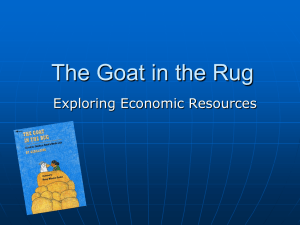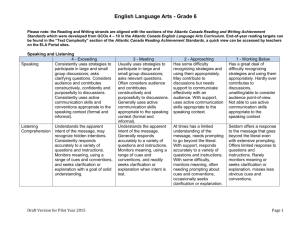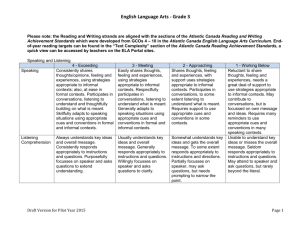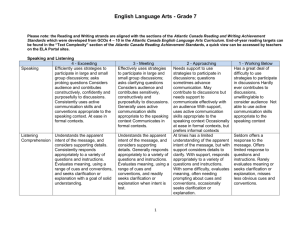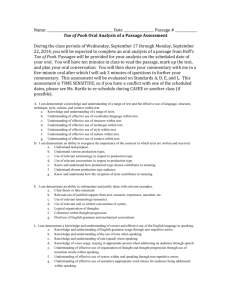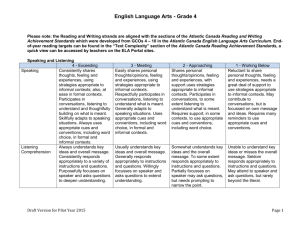ELA Grade 5 - August 2014
advertisement
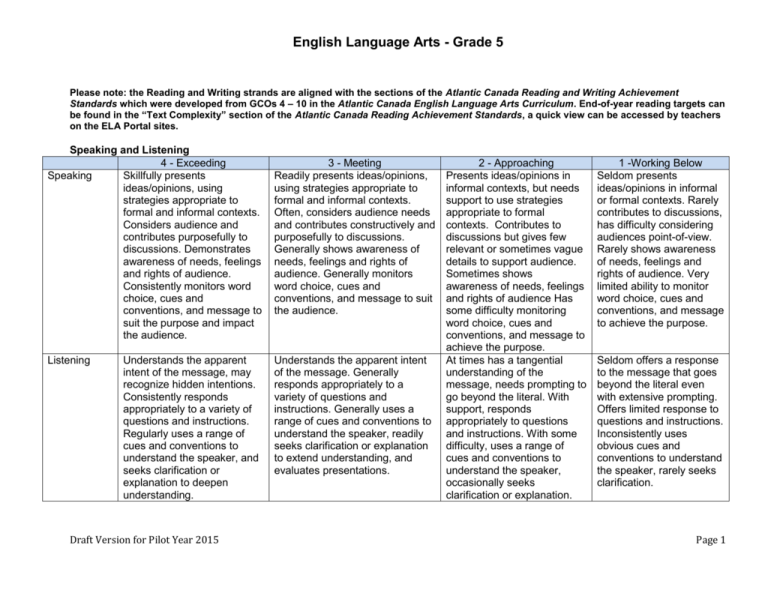
English Language Arts - Grade 5 Please note: the Reading and Writing strands are aligned with the sections of the Atlantic Canada Reading and Writing Achievement Standards which were developed from GCOs 4 – 10 in the Atlantic Canada English Language Arts Curriculum. End-of-year reading targets can be found in the “Text Complexity” section of the Atlantic Canada Reading Achievement Standards, a quick view can be accessed by teachers on the ELA Portal sites. Speaking and Listening 4 - Exceeding Speaking Skillfully presents ideas/opinions, using strategies appropriate to formal and informal contexts. Considers audience and contributes purposefully to discussions. Demonstrates awareness of needs, feelings and rights of audience. Consistently monitors word choice, cues and conventions, and message to suit the purpose and impact the audience. Listening Understands the apparent intent of the message, may recognize hidden intentions. Consistently responds appropriately to a variety of questions and instructions. Regularly uses a range of cues and conventions to understand the speaker, and seeks clarification or explanation to deepen understanding. Draft Version for Pilot Year 2015 3 - Meeting Readily presents ideas/opinions, using strategies appropriate to formal and informal contexts. Often, considers audience needs and contributes constructively and purposefully to discussions. Generally shows awareness of needs, feelings and rights of audience. Generally monitors word choice, cues and conventions, and message to suit the audience. Understands the apparent intent of the message. Generally responds appropriately to a variety of questions and instructions. Generally uses a range of cues and conventions to understand the speaker, readily seeks clarification or explanation to extend understanding, and evaluates presentations. 2 - Approaching Presents ideas/opinions in informal contexts, but needs support to use strategies appropriate to formal contexts. Contributes to discussions but gives few relevant or sometimes vague details to support audience. Sometimes shows awareness of needs, feelings and rights of audience Has some difficulty monitoring word choice, cues and conventions, and message to achieve the purpose. At times has a tangential understanding of the message, needs prompting to go beyond the literal. With support, responds appropriately to questions and instructions. With some difficulty, uses a range of cues and conventions to understand the speaker, occasionally seeks clarification or explanation. 1 -Working Below Seldom presents ideas/opinions in informal or formal contexts. Rarely contributes to discussions, has difficulty considering audiences point-of-view. Rarely shows awareness of needs, feelings and rights of audience. Very limited ability to monitor word choice, cues and conventions, and message to achieve the purpose. Seldom offers a response to the message that goes beyond the literal even with extensive prompting. Offers limited response to questions and instructions. Inconsistently uses obvious cues and conventions to understand the speaker, rarely seeks clarification. Page 1 English Language Arts - Grade 5 Reading and Viewing 4 - Exceeding Level of Text Independently selects and Complexity constructs meaning from texts at a complexity considered beyond target level. 3 - Meeting Selects and constructs meaning from texts at a complexity considered at target level. 2 - Approaching Has some difficulty constructing meaning from texts at a complexity considered at target level. Reads independently somewhat below target level (not more than one year). Strategies and Behaviours Consistently adjusts strategies to construct meaning from texts, even when texts are unfamiliar. Makes insightful predictions based on a variety of textual details. Routinely adjusts strategies to construct meaning. May need reminders with unfamiliar texts. Reads most unfamiliar words. Makes predictions based on a variety of textual details. Requires support to use strategies to construct meaning from grade-level texts. Needs prompting to recognize details to make and adjust predictions. Comprehension Consistently attends to important information in large amounts of grade-level texts to obtain literal and implied meanings. Interprets subtleties in text features and literary phrasing. Always expresses personal points of view and provides relevant details to support insightful rationales. Usually attends to important information in shorter grade-level texts to obtain literal and implied meanings. Is beginning to interpret subtleties in text features and literary phrasing. Often expresses personal points of view, evaluates texts, and provides adequate details to support rationales. To some extent attends to important information in gradelevel texts to obtain literal and implied meanings. Occasionally expresses personal points of view and needs support to interpret text features and literary phrasing. Rationales reflect a surface understanding of the text. Demonstrates appropriate comprehension when reading texts below grade level. Draft Version for Pilot Year 2015 1 -Working Below Has a great deal of difficulty constructing meaning from texts at a complexity considered on target. Reads independently well-below grade-level targets (more than one year). Requires a great deal of direction to use strategies to construct meaning grade-level texts. Often guesses at meaning and rarely checks for understanding unless prompted. Has difficulty obtaining important information from grade-level texts. Demonstrates appropriate comprehension when reading texts well-below grade level. Page 2 English Language Arts - Grade 5 Writing and Representing 4 - Exceeding Strategies Consistently employs and grade-level strategies. Behaviours Drafts show attention to developing a main idea with specific and relevant details. Writes independently due to increase control of conventions. Errors typically related to risktaking. Traits Demonstrates all aspects (content, organization, word choice, voice, sentence structure, conventions) of strong writing as evidenced over time in multiple pieces. Published pieces are purposeful and easy to understand, with few errors. Text Forms Selects forms and presentation mode (written, visual, multimedia) based on audience and purpose. Includes features Draft Version for Pilot Year 2015 3 - Meeting Generally employs gradelevel strategies. Drafts include a main idea and sufficient information to influence the reader. Uses an editing checklist with minimal support. Rereads for fluency, substitutes ideas, uses criteria to select/share. 2 - Approaching With some support uses grade-level strategies to generate drafts and pieces of drafts. Needs support with editing, to focus on a main idea and to complete a piece of writing. 1 -Working Below Requires a great deal of direction to use strategies and behaviours outlined in the end-of-Grade 5 standards. Rarely completes a piece of writing independently. Demonstrates all aspects (content, organization, word choice, voice, sentence structure, conventions) of appropriate writing as evidenced over time in multiple pieces. Published pieces are clear with enough specific information to communicate the writing purpose. Errors do not interfere with meaning. Demonstrates most aspects (content, organization, word choice, voice, sentence structure, conventions) of appropriate writing as evidenced over time in pieces. Published pieces may be vague and unfocussed in places, may have many errors but the writing meets basic requirements to communicate the purpose. Overall, meaning is understood by audience. With prompting, follows directions to organize according to form, considers audience and purpose. With support, includes features according to form. May demonstrate some aspects (content, organization, word choice, voice, sentence structure, conventions) of appropriate writing as shown in evidence over time but drafts and pieces of drafts may be repetitive, copied, unclear, or unfocused. Published pieces are difficult to follow and do not meet basic requirements. Errors interfere with meaning. Follows directions to organize according to form, considers audience and purpose. Often includes features according to form. Is unable to follow directions to organize according to form. Is unclear about audience and purpose. Resists using organization tools, such as graphic organizers, or uses them Page 3 English Language Arts - Grade 5 according to form. Draft Version for Pilot Year 2015 ineffectively. Page 4
